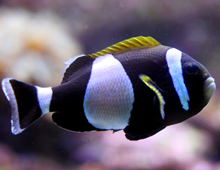Description: The Wideband anemonefish differs from its other clownfish relatives in the fact that it has a large white band in the center of its body that broadens with age. It also has two other smaller white bars on its dark brown to black body. The caudal fin has a pale posterior margin.
Size: They reach a maximum length of six inches (15 cm).
Behavior: The Wideband anemonefish, like other anemonefish, has a symbiotic relationship with certain anemones (they both benefit). Both are protected from predators and exchange nutrients. The anemone provides protection, shelter and supplies food for the clownfish. In return, the clownfish defends the anemone from predators and parasites and provides nitrogen, which aids the anemone’s tissue growth. The clownfish is able to live among the anemone’s stinging tentacles due the protective, slimy mucus that coats the body. The social group of this anemonefish, within its host anemone, is one of hierarchy. There is one large dominant, sexually active female, one smaller sexually active male and a few smaller juveniles. When the dominate female leaves or dies, the largest male will change sex (sequential hermaphrodite) and become the dominant female and then the next largest male will become the sexually active one.
Diet: The diet of this anemonefish consists of copepods, algae, isopods and zooplankton.
Communication: Before breeding, to attract the female, the male communicates his intentions through chasing, biting at the substrate and extending his fins.
Reproduction: A nest is prepared on a flat, bare surface, such as rock, near the host anemone in order for the eggs to receive protection from predators. The female lays her sticky eggs in the nest where the male fertilizes and aerates them. The male guards and protects the eggs until they hatch.
Habitat/range: They live on offshore reefs among anemones in cooler, temperate waters from southern Queensland to northern New South Wales and Lord Howe Island.
Status: Not assessed for the IUCN Red List.



